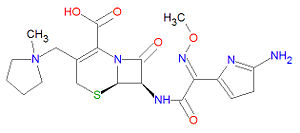Cefepime
|
| |||||||
| cefepime | |||||||
| |||||||
| Uses: | antibiotic drug | ||||||
| Properties: | beta-lactam | ||||||
| Hazards: | see drug interactions | ||||||
| |||||||
Cefepime is a fourth-generation cephalosporin antibiotic that was developed in 1994. It has more activity than third-generation cephalosporins against Gram-postive and Gram-negative bacteria, and because of this, its use is typically reserved for severe nococomial pneumonia, infections of a multi-resistant bacterial strain and the treatment of febrile neutropenia. It is indicated for the treatment of pneumonia caused by Streptococcus pneumoniae, Pseudomonas aeruginosa, Klebsiella pneumoniae, or Enterobacter species and also for empiric treatment of febrile neutropenic patients and urinary tract infections caused by Escherichia coli or Klebsiella pneumoniae for severe infections, or, when concurrent bacteremia is present, for milder infections of Escherichia coli, Klebsiella pneumoniae, or Proteus mirabilis. It is also used to treat skin and skin structure infections caused by methicillin-resistant strains of Staphylococcus aureus and Streptococcus pyogenes. It also used in combination with metronidazole for complicated intra-abdominal infections caused by caused by many bacteria.
Mechanism of action
Like other cephalosporins and penicillins, cefepime works by binding to specific penicillin binding proteins and thus inhibiting the last stage of bacterial cell wall synthesis (the peptidoglycan layer), leading to autolysis of the bacterial cells by autolyic enzymes such as autolysins. Whereas other cephalosporins and penicllins are degraded beta-lactamases, cefepime is stable and is therefore a front line agent when infection with Enterobacteriaceae is known or suspected.
Chemistry
Cefepime has the IUPAC chemical name (6R,7R)-7-[[(2Z)-2-(2-amino-1,3-thiazol-4-yl)-2-methoxyiminoacetyl]amino] -3-[(1-methylpyrrolidin-1-ium-1-yl)methyl]-8-oxo-5-thia-1-azabicyclo[4.2.0]oct-2-ene-2-carboxylate, chemical formula C19H24N6O5S2 and molecular mass 480.5611 g/mol. It contains a beta-lactam moiety that is also present in other cephalosporins and penicillins, but is much more stable against beta-lactamases.
Synonyms and brand names
Cefepime is also called cefepima in Spanish and cefepimum in Latin. It is sold under the brand names Maxcef®, Cepimax®, Cepimex® and Axepim®.
External links
The most up-to-date information about Cefepime and other drugs can be found at the following sites.
- Cefepime - FDA approved drug information (drug label) from DailyMed (U.S. National Library of Medicine).
- Cefepime - Drug information for consumers from MedlinePlus (U.S. National Library of Medicine).
- Cefepime - Detailed information from DrugBank.
